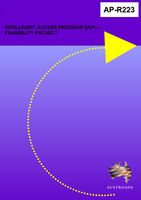Freight

- Publication no: AP-R223-03
- ISBN: 0 85588 656 0
- Published: 1 June 2003
- PDF (free) Download
Vehicle telematics enables the provision of services to transport operators that can monitor the compliance of vehicles with respect to access conditions set by jurisdictions. Austroads initiated a feasibility project to investigate this capability.
The purpose of the Austroads 'Intelligent Access Program (IAP) Feasibility Project' was to identify the applications to which jurisdictions could apply the IAP and to demonstrate the feasibility within the following sub-project components: It was found that IAP can provide significant benefits to jurisdictions across all areas of activity including: improved road safety, reduction in infrastructure wear, reduction in environmental effects, better managing public perceptions and expectations of heavy vehicle movements, and optimisation of the road freight policy and operations tasks, including optimisation of the on-road enforcement activities.
Additionally the transport industry can benefit from improved productivity. In-line with the findings, a staged IAP implementation is recommended. The first stage (ie. Stage 1) addresses the key elements identified in the sub-project components. It effectively minimises the impact to stakeholders and caters for the potential conflict areas that were identified.
Stage 1 effectively permits a series of applications that can be delivered now. The recommended specific IAP applications for implementation in Stage 1 are as follows (not in any priority order):
- Dangerous goods vehicles.
- Specialised rigid vehicles.
- Low loaders route.
- Mass concession scheme.
- Performance Based Standards/Innovative Vehicles.
- Higher Mass Limits.
- 1. INTRODUCTION
- 2. LAYOUT OF REPORT
- 3. BACKGROUND
- 4. TECHNICAL FEASIBILITY AND STANDARDS
- 5. REGULATORY FEASIBILITY AND IMPLICATIONS FOR JURISDICTIONS
- 6. INTENDED APPLICATIONS AND BUSINESS FEASIBILITY
- 7. PROOF OF CONCEPT PILOTS, DEMONSTRATIONS AND OTHER LEARNINGS
- 8. IMPLEMENTATION STRATEGY
- 9. CONCLUSIONS
- APPENDIX A GLOSSARY OF TERMS
